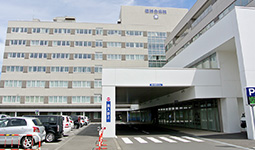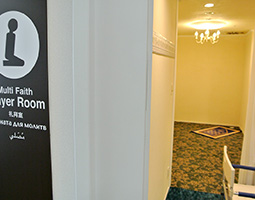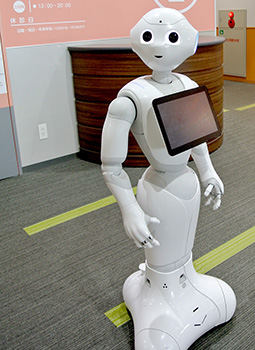Home > Highlighting JAPAN > Highlighting Japan August 2017 > The Future by Design
Highlighting JAPAN
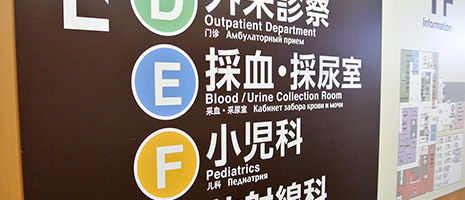
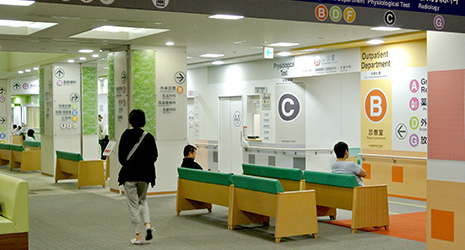
Hospital “Check In” Made Simple
A hospital in Hokkaido has drawn on airport design among other influences to better serve its growing influx of foreign patients.
Increasing numbers of foreign tourists, particularly from Asia, are visiting Japan’s northernmost island of Hokkaido, one of the country’s most popular tourist destinations. In fiscal 2016, the number of guest nights for foreign visitors in Sapporo (1.95 million), a popular city base for sightseeing in Hokkaido, reached 2.09 million, a new record high for the fifth consecutive year. With this increase, the number of inbound tourists requiring emergency healthcare has also increased. Sapporo is responding to this need by developing medical facilities where people from abroad can receive treatment with a sense of security.
Sapporo Higashi Tokushukai Hospital was one of the first hospitals in Sapporo to focus on treating patients from abroad. In 2013, the hospital set up an International Medical Support Office staffed with full-time interpreters who together handle ten languages, including English, Russian, Chinese, Korean and Spanish. It has also established a system that can accommodate both emergency patients and medical tourists seeking treatment or checkups.
In 2015, the hospital added facilities for foreign patients that were designed based on the concept of an airport. The hospital looked at airports including Hokkaido’s own New Chitose Airport. The airport won the MILT (Ministry of Land, Infrastructure, Transport and Tourism) Minister’s Merit Award for Promoting Barrier-Free Design in 2011 for its sophisticated barrier-free initiatives, including six-language information signs and large pictograms that are easy for anyone to follow in the international terminal.
“The airport is visited by many people from abroad and has a number of ideas to receive them. When we added facilities to the hospital, we looked at designs including signs and colors used at airports to guide foreign visitors,” says Shingo Kamano, a member of the hospital’s general affairs section.
The hospital’s main entrance is now approached by a covered driveway similar to those seen at international airports. Inside the building, departments are differentiated by colors, and many pictograms are used in the hospital’s guides and floor maps. In addition to Japanese and English, Chinese and Russian are used in many signs.
A lounge exclusively for foreign patients has been set up next to the International Medical Support Office, where interpreters are standing by ready for prompt action. A multi-faith Prayer Room has been established next to the waiting room. If Muslim patients are hospitalized, they are provided with a halal menu.
Because of these initiatives, the hospital was accredited in 2015 under the Japan Medical Service Accreditation for International Patients system (promoted by the Ministry of Health, Labour and Welfare since fiscal 2011) overseen by the Japan Medical Education Foundation.
The number of foreign patients visiting the hospital has risen sharply, from around 400 in fiscal 2014 to around 640 in fiscal 2015 and around 1,200 in fiscal 2016.
“Because medical care is related to human life, I strive to fully understand doctors’ explanations before I interpret what they say for patients. I feel that foreign patients are relieved when they can communicate in their mother tongue,” says Yukari Matsumura, an interpreter at the International Medical Support Office.
At Sapporo Higashi Tokushukai Hospital, when doctors explain their diagnosis or treatment to foreign patients who do not speak Japanese, interpreters sit with them. If no interpreters are available, patients can communicate in their native tongue using a videophone function on a tablet.
Since last year, Pepper, a humanoid robot, has been stationed on the first floor and provides guidance on the hospital in Japanese. There are plans to have the robot speaking English and Chinese in the future.
“We plan to develop our system further and add languages that can be used in the hospital so that patients from as many countries as possible can receive treatment with a sense of security. We would like to disseminate our expertise on treating foreign patients to other medical institutions in Hokkaido,” says Toshiki Sasaki, a member of the hospital’s medical affairs section.
People-friendly designs lead to services that are accessible to patients from wherever they hail.
© 2009 Cabinet Office, Government of Japan
